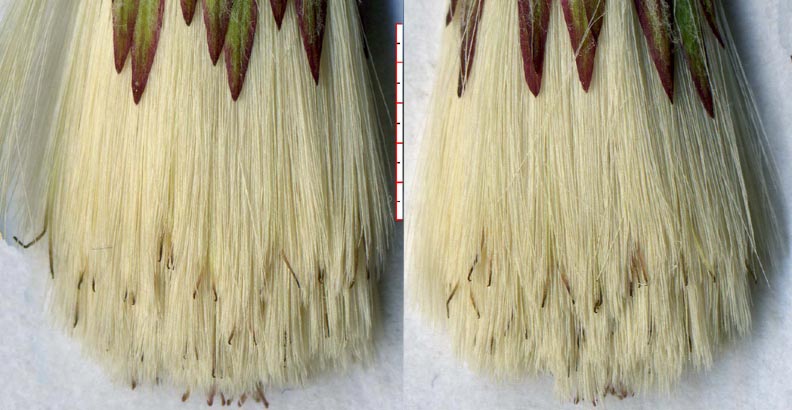
Both sides of head; only style branches apparent.


In May 2010 I found a small population of C. carduacea plants on a high ridge above the Deadman's Creek valley at the SE corner of Purola Preserve, lacking even vestigial ligules — apparent ‘bimorphic’ heads. In counting floret types, among the eligulate florets I found some with long corolla tubes, ca. greater than half the length of the style. On a hunch I carefully removed all but the peripheral florets from a longitudinal half–section of a head, and then tallied the peripheral florets separately. 8 of 9 of these florets had long corollas; one was short - as would be expected for an eligulate female floret (extracting all and only the peripheral florets is not an exact task). The extracted florets from inside the head were examined. Only perfect (central) florets and eligulate female florets with short corollas were found. I concluded that the apparent bimorphism was illusory and that the long–tubular florets constituted a distinct peripheral series. I have subsequently realized that this is a late spring (and also fall/winter) phase replacement for the early spring ligulate series. And later floret counts of such heads in late spring (both species) indicates that the shift to long–tubular forms is not always total, with one or several reduced ligulate florets being present (as in this instance).
For the head as a whole (both halves) the resulting number of florets by type were:
| long eligulate female florets: | 17 |
| floret with a crimson reduced ligule: | 1 |
| short eligulate female florets: | 46 |
| central perfect florets: | 9 |
| total florets in the head: | 73 |
|---|



A count of all florets from this C. carduacea head compared with the averages for a head with reduced ligules supports the interpretation of the long–tubular florets as a distinct peripheral floret form.
| late spring phase | averages for reduced ligulate form |
|
|---|---|---|
| long–tubular, pistillate | 17 (+ 1 reduced) | 18 (reduced ligules) |
| short–tubular, pistillate | 46 | 39 |
| central perfect | 9 | 12 |
| total: | 73 | 69 |